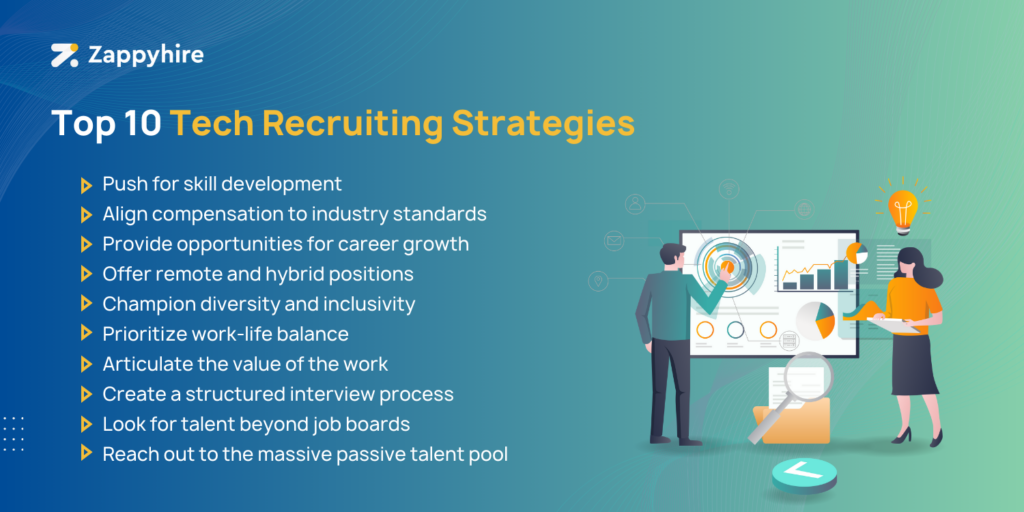
* Blog updated on 20th July, 2025
Recruiting technical talent has become incredibly challenging with around an overwhelming 90% of companies facing difficulties in doing so.
The evolving nature of technology constantly reshapes the skill sets in demand, requiring a dynamic approach to sourcing and retaining technical talent.
Tech talent encompasses a spectrum of profiles crucial for technology-driven industries. This includes software developers, data scientists, cybersecurity experts, AI and machine learning engineers, cloud architects, network administrators, UX/UI designers, and more.
The high demand for specialized technical skills coupled with a limited pool of experienced professionals adds complexity to the recruitment process.

Hiring and retaining tech talent has become more challenging than ever
Identifying candidates with the right skill set, expertise in cutting-edge technologies, and a forward-thinking mindset is a significant hurdle in tech recruitment.
Here’s a brief look at some of the top challenges in recruiting technical talent.
The evolution of technology often outpaces the traditional education system
Emerging technologies like artificial intelligence, machine learning, cybersecurity, and data science demand specialized skills that are not readily available in the job market.
Identifying candidates proficient in these niche areas and battling the skills gap is a challenge for recruiters.
The demand for tech talent far exceeds the available pool of qualified candidates
This high demand is prevalent not just in tech companies but across various industries that require technical skills for digital transformation.
The competition for a limited number of skilled professionals intensifies the hiring struggle.
The COVID-19 pandemic catalyzed remote work, opening up opportunities for global recruitment
The sudden rise in remote and hybrid work means increased competition on a global scale for top talent.
Remote work has expanded the candidate pool but also introduced challenges in assessing candidates’ soft skills, collaboration abilities, and cultural fit.
The tech industry continues to face challenges related to diversity and inclusion
There’s a need to bridge the gender gap and promote inclusivity among underrepresented groups.
Companies are striving to provide more DEI initiatives to create inclusive hiring processes to attract diverse talent, but achieving this goal remains an ongoing challenge.
Retaining tech talent poses its own set of challenges.
High-demand skills mean employees often receive enticing offers from competitors, leading to high turnover rates.
Retention strategies focusing on career development, work-life balance, and a positive company culture become crucial in retaining top talent.
There is a palpable shortage of tech workers
There’s a significant shortage of tech workers globally, affecting industries across the board. Over 81% of organizations face this scarcity, leading to unfilled roles and lost revenue.
Estimates suggest over 85 million jobs might remain vacant by 2030 due to a lack of skilled workers.
This shortage impacts growth and innovation, making it challenging for companies to meet their hiring targets.
Additionally, the competitive landscape further intensifies the hiring challenge. The scarcity of skilled professionals results in a talent war among companies vying for the same pool of candidates.
Retaining top tech talent also becomes critical, as they are often lured by lucrative offers from other organizations.
How to recruit tech talent efficiently
Even with shifts in the industry, acquiring tech talent remains a challenge. Overcoming this demand-supply gap demands innovative strategies and a meticulous examination of evolving trends in recruitment and retention within the tech sector.
10 tech recruiting strategies to hire the best tech talent in the market
To recruit top tech talent, focus on offering skill development opportunities, competitive compensation, and clear paths for career growth. In addition to that, a well-structured and optimized recruitment process, along with a positive candidate experience, plays a crucial role in attracting top talent.
Let’s look at the top tech recruitment strategies more in detail.

A push for skill development is needed
Nearly half of tech workers contemplate job shifts due to insufficient skill development resources.
Recognizing the widening tech talent gap, employers are already proactively upskilling their workforce.
However, with only 13% of employers feeling confident in securing and retaining necessary tech talent, a substantial shortfall remains.
Encouraging certifications, workshops, and mentorship programs not only boosts tech workers’ skills but also nurtures a sense of investment in their career growth and the organization’s future.
Align compensation to industry standards
A strategic approach to compensation and talent retention is crucial to mitigate the risk of losing valuable personnel.
Statements like “My salary doesn’t match industry standards” and “I handle responsibilities beyond my role without proper compensation” resonate among many.
A striking 53% of AWS professionals attribute their job considerations to the absence of basic salary hikes.
Moreover, a significant 76% of job movers experience an average pay increase of 25%, highlighting a clear trend – failing to compensate top talent might prompt them to seek better opportunities elsewhere.
Addressing this challenge involves periodic salary evaluations.
Tech professionals often monitor industry benchmarks, so offering competitive compensation is essential.
Conducting annual or semi-annual reviews helps ensure that salaries remain attractive and in line with industry standards.
Offering competitive benefits beyond salary, such as healthcare, flexible work arrangements, professional development opportunities, and a conducive work culture, can further enhance the attractiveness of the remuneration package.
More opportunities for career growth should be provided
Reports suggest that over 40% of tech workers quit because of limited career progression.
To retain talent, it’s important to provide engaging projects that give way to skill development and personal growth.
Offering such initiatives not only retains talent but also cultivates a thriving workforce invested in continuous improvement.
Also, encouraging internal mobility, where tech workers can explore varied roles and responsibilities, cultivates a sense of ownership and career advancement.
Mentorship programs and feedback mechanisms to contribute significantly to employee growth, enhancing tech talent retention rates and overall job satisfaction.
Offer remote and hybrid positions whenever possible
Tech talent shows a strong preference for remote work over relocation.
A McKinsey report underscores that tech talent vastly favors remote work over relocating for a job.
Forbes echoes this sentiment, emphasizing that remote and hybrid work setups are especially advantageous to hire top tech talent.
This preference aligns with the flexibility and adaptability that is inherent in tech roles, emphasizing the importance of accommodating remote work options to attract and retain top tech talent.
Diversity and inclusivity are critical
The tech industry faces significant diversity challenges.
Only 15% of the tech workforce represents diverse ethnic backgrounds, while gender diversity remains stagnant at 17%, notably lower than the 49% average for all other professions.
A diverse workplace is pivotal for innovation and overall company performance. However, the industry faces notable disparities, particularly in leadership roles.
Prioritizing inclusive workplaces and actively sourcing tech talent from diverse pools can significantly augment creativity and problem-solving within tech teams.
Prioritize work-life balance
Employee burnout is prevalent in the tech industry due to demanding workloads and high-pressure environments.
Over half of men (56%) and nearly seven in ten women (69%) struggle to unwind after their workday concludes.
A significant 43% express disengagement from their work, with 27% failing to perceive its value.
Additionally, 51% feel they’re falling short of their potential. Globally, alarming statistics reveal that two in five IT professionals face a high risk of burnout.
Heavy workloads, tight deadlines, disparities in compensation and a culture of constantly being “on” contribute significantly to burnout in the tech industry.
Enable realistic workloads, prioritize tasks, and avoid overloading employees to prevent burnout. Emphasize quality over quantity in work output.
Also, promote the practice of setting clear boundaries between work and personal life, cultivating an environment where employees feel they can disconnect without repercussions.

Articulate the value of the work
When aligning with market standards regarding compensation and benefits, emphasizing purpose and opportunity becomes pivotal.
Showcase how the role contributes to meaningful projects or innovations.
For instance, explaining how a software engineer’s work enhances user experiences, making everyday tasks simpler for millions of users.
Illustrate how the job aligns with broader company goals.
For example, a data analyst’s role in analyzing trends that directly inform strategic decisions, shaping the company’s future.
By passionately conveying the intrinsic value of a role and its associated rewards, you tap into the allure of the role itself.
You’ll allow the sense of fulfilment and growth opportunities to naturally draw candidates.
This makes candidates leave the “fear of missing out” mindset and it’ll organically influence their decision-making.
Create an effective and efficient interview process
Prioritize a structured interview process meticulously designed to mirror the specific job requirements.
Your approach should be built around these criteria, empowering interviewers through automated pre-screening tools.
Prioritize a structured interview process meticulously designed to mirror the specific job requirements.
Your approach should be built around these criteria, empowering interviewers through automated pre-screening tools.
These tools can dramatically accelerate early-stage screening. “What used to take days now takes minutes,” says Ms. Sangeeta Singh, Director of TA at Shaadi(dot)com. “We’ve automated early-stage screening using Zappyhire. It filters out unqualified applicants instantly, improving quality and reducing recruiter fatigue.”
Capabilities like automated video interviews have the potential to empower interviewees by offering flexibility, reducing biases, and enhancing their ability to showcase skills.
These platforms allow candidates to complete interviews at their convenience, eliminating geographical constraints and accommodating diverse schedules.
Capabilities like automated video interviews have the potential to empower interviewees by offering flexibility, reducing biases, and enhancing their ability to showcase skills.
These platforms allow candidates to complete interviews at their convenience, eliminating geographical constraints and accommodating diverse schedules.

Show that your focus isn’t merely on identifying the “top” tech talent – instead, strive to pinpoint the ideal tech talent for your organizational ethos and culture.
This approach ensures each interview is fair, ethical, and proficient, paving the way for a conducive and equitable interview environment.
Venturing beyond typical tech hubs is crucial
Incredible tech skills can come from anywhere. It’s about giving everyone a shot, no matter their background.
The focus should be on providing opportunities to enthusiastic tech workers from diverse backgrounds, recognizing their potential to contribute significantly.
Focusing on skills during the hiring process not only mitigates biases but also ensures fairness in recruitment practices.
Embracing recruitment technology that prioritizes skills can significantly enhance fairness and effectiveness in hiring, benefiting both employers and candidates.
Reach out to the massive passive talent pool
To attract the ideal candidates, hiring managers need to initiate contact with tech workers who might not actively seek new roles.
It involves reaching out to desirable candidates, regardless of their current job-seeking status.
Many of these professionals are open to conversations about potential opportunities, even if they haven’t explicitly indicated their interest in a job change.
Reaching out to these passive candidates is crucial considering that around 70% of the global workforce falls into this category.
Relying solely on recruiting active job seekers might limit access to a substantial talent pool, potentially missing out on highly skilled tech workers who aren’t actively searching for new roles.
The pursuit of tech talent demands an innovative and adaptive approach
With a majority of companies facing tech recruitment challenges, the evolving nature of technology continually redefines skill requirements. This underscores the need for dynamic talent acquisition strategies.
Innovation in skill development, fair compensation, career growth opportunities, and flexible work arrangements stand as pillars upon which companies can build a sustainable and thriving workforce in the tech sphere.
Embracing these tech recruiting strategies not only addresses the immediate hiring hurdles but also positions your organization to adapt to the tech landscape. It ensures that you attract, retain, and nurture top-tier tech talent for long-term success.
Do you want to overcome this dire challenge? To identify top tech talent and quickly hire them – Try Zappyhire!





